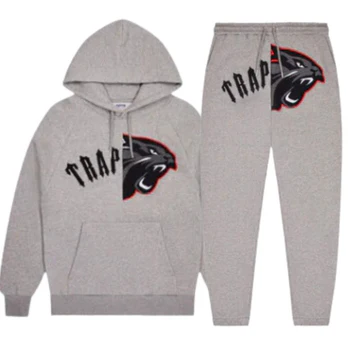Trapstar is not just a clothing brand; it’s a cultural movement that has become synonymous with streetwear, music, and luxury fashion. Founded in 2005 by Mikey and Lee, Trapstar the London-based brand has grown from a small operation into a global powerhouse, blending bold designs, urban influences, and high-end appeal. Known for its signature graphic tees, hoodies, and accessories, Trapstar has cultivated a loyal following and positioned itself as one of the leading names in the world of streetwear.
Origins of Trapstar
Trapstar began with a simple yet powerful concept: create streetwear that spoke to the youth culture. The founders, originally from London, were immersed in the city’s gritty, fast-paced environment, and they sought to create a brand that encapsulated this energy. Early on, Trapstar was primarily known for producing t-shirts with edgy, graphic prints that mirrored the rawness of street life. The name itself, “Trapstar,” is a nod to the hustle and grind of life in the “trap,” or inner-city areas where people strive to make it against the odds.
The initial designs were worn by close friends, influencers, and members of the local music scene, especially the burgeoning grime and hip-hop scenes in the UK. This organic approach helped Trapstar build a grassroots following, which quickly expanded as the brand’s bold designs began to resonate with a global audience.
Streetwear Meets Luxury
While Trapstar started as a brand rooted in street culture, it didn’t take long for it to gain recognition in the luxury fashion world. As streetwear began to influence high fashion in the late 2010s, Trapstar was at the forefront of this evolution. The brand became known for its ability to merge luxury materials with urban design sensibilities.
Trapstar’s collaborations with major brands and artists, such as Puma, Adidas, and even popular musicians like Jay-Z and Rihanna, elevated its status in the luxury fashion sphere. Limited-edition drops and exclusive collections have made Trapstar items highly coveted, with pieces often selling out in minutes. The brand’s ability to seamlessly blend high-end materials like leather, velvet, and premium cotton with streetwear aesthetics made it a favorite among those seeking something fresh, exclusive, and aspirational.
Iconic Designs and Aesthetic
At the heart of Trapstar’s success is its unique design language. The brand has developed a distinct visual style characterized by bold typography, eye-catching graphics, and edgy iconography. The famous Trapstar logo, often displayed on the chest or back of its garments, has become a symbol of status and style. The designs often feature provocative messages and cultural references that resonate with young, rebellious individuals who reject traditional norms.
The brand’s aesthetic is influenced by a range of cultural movements, including hip-hop, graffiti, and punk. Trapstar has consistently incorporated these elements into its collections, resulting in a style that feels both authentic and contemporary. From oversized jackets to fitted tracksuits, each piece in the Trapstar collection tells a story of rebellion, resilience, and self-expression.
The Trapstar Community
Trapstar is more than just a brand—it’s a community. Over the years, it has built a loyal fanbase of fans who not only wear the clothes but live the culture that Trapstar represents. The brand has found its place within music, art, and social movements, which has played a significant role in its growth. Musicians, athletes, and influencers continue to wear Trapstar, helping to maintain its relevance in the ever-changing fashion industry.
Moreover, Trapstar has embraced digital platforms and social media, allowing it to connect directly with its audience. Through Instagram and other channels, the brand has cultivated an inclusive, global community that shares a passion for creativity and style. This level of engagement has made Trapstar not just a brand but a cultural touchstone for the youth of today.
Collaborations and Expansions
The brand’s collaborations have been instrumental in shaping its identity. By working with established names in fashion, sports, and entertainment, Trapstar has been able to push the boundaries of streetwear and maintain a fresh, cutting-edge appeal. Notable collaborations include partnerships with Adidas, Puma, and even rapper Jay-Z’s Roc Nation label, which helped push Trapstar’s designs into the mainstream.
Trapstar has also expanded beyond clothing into accessories, footwear, and even tech products, all while maintaining its core identity of bold, street-inspired luxury. With each collaboration, the brand continues to expand its cultural footprint, influencing fashion, music, and youth culture around the globe.
Looking Ahead: The Future of Trapstar
As Trapstar continues to grow, it faces the challenge of staying true to its roots while embracing the future. The brand is increasingly focused on sustainability, Trapstar Tracksuit innovation, and staying ahead of fashion trends. The influence of social media and digital spaces will likely continue to play a key role in shaping its future, as it seeks to engage with a younger generation of fashion-conscious individuals.
One thing is for certain: Trapstar’s commitment to creativity, quality, and authenticity will ensure that it remains a dominant force in streetwear and beyond. With a dedicated fanbase, global recognition, and a cultural impact that stretches far beyond fashion, Trapstar’s journey is only just beginning.
Conclusion
Trapstar is a brand that has managed to redefine streetwear by blending luxury with raw, urban aesthetics. From its humble beginnings in London to becoming a global icon in fashion, the brand represents a unique fusion of culture, art, and style. As it continues to push boundaries and influence trends, Trapstar is not just a clothing line—it’s a testament to the power of street culture and the enduring appeal of youth-driven fashion.




